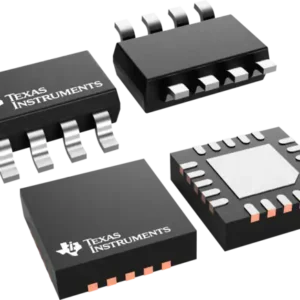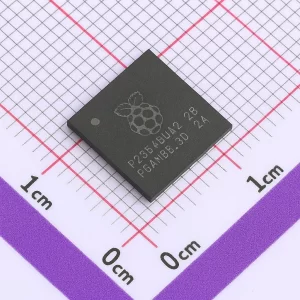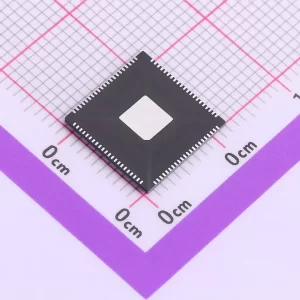MSPM0C1104SDSGR Texas Instruments MSPM0C1104SDSGR Microcontroller (WSON-8)
-
WSON-8 for slim boards & thermal contact — exposed pad helps spread heat and stiffen the mount.
-
Fast 12-bit ADC with internal/external reference flexibility.
-
Crystal-less 24 MHz in many designs, minimizing BOM and height.
MSPM0C1104SDSGR – 24-MHz M0+ MCU with 12-bit ADC and ultra-low power in an 8-pin WSON package
MSPM0C1104SDSGR brings the MSPM0C110x essentials to a slim 8-pin WSON (DSG) package that’s friendly to high-volume assembly and offers excellent board contact for thermal paths. Even with the minimal pin count, you still get a 24-MHz Arm® Cortex®-M0+, 16KB Flash / 1KB SRAM, a 12-bit ADC up to 1.5 Msps, and the foundational serial interfaces (UART, I²C (FM+), SPI). The trimmed internal SYSOSC enables crystal-less 24 MHz in many designs, shrinking BOM and height for wearables, tags, and ultra-compact sensors.
Use SDSGR when you need more thermal and mechanical robustness than SOT-23 in a similarly tiny footprint—think sealed enclosures, flex PCBs, or devices that see frequent handling or temperature swings.
Highlights
-
Slim, assembly-friendly footprint: WSON-8 (DSG) with large thermal/ground pad for heat spreading and mechanical stability.
-
Mixed-signal in tiny spaces: 12-bit ADC (to 1.5 Msps) plus internal 1.4 V / 2.5 V references for stable measurements.
-
Right-sized performance: 24-MHz M0+, 16KB Flash / 1KB SRAM for compact control loops and sensor stacks.
-
Crystal-less operation: internal SYSOSC often eliminates the need for an external clock.
-
Ultra-low power: typical ~87 µA/MHz run, ~5 µA standby, ~200 nA shutdown for battery-first designs.
-
Package-aware flexibility: the family supports up to 18 GPIO—map what you need within the 8-pin budget.
Specifications
| Parameter | Value |
|---|---|
| Core | Arm Cortex-M0+ to 24 MHz (SYSOSC) |
| Program/Data | 16KB Flash / 1KB SRAM |
| ADC | 12-bit, up to 1.5 Msps; internal 1.4 V / 2.5 V VREF options |
| Peripherals | UART, I²C (FM+), SPI (≤12 Mbps); timers up to 14 PWM ch. (family level) |
| GPIO | Up to 18 (package-limited in 8-pin builds) |
| Power | 1.62–3.6 V; RUN ~87 µA/MHz; STANDBY ~5 µA; SHDN ~200 nA |
| Package | 8-pin WSON (DSG) – orderable SDSGR |
| Base Product Number | MSPM0C1104 |
Applications
-
Ultra-slim wearables, tags, badges — thin stackup, robust assembly, long battery life.
-
LED effects & drivers — small PWM control for indicators, beacons, or light bars.
-
Thermally aware compact sensors — leverage the exposed pad for thermal coupling to the measured medium or chassis.
-
Tiny utility monitors — voltage/temperature/pressure sensing with UART/I²C reporting.
-
Sealed enclosures & flex PCBs — low profile, good heat path, and rugged attach.
WSON-specific design notes
-
Exposed pad = ground & thermal path: tie the center pad to GND with a stitched thermal land and via array (e.g., 4–9 microvias) into the ground plane. Keep short returns for ADC/VREF nodes.
-
Stencil & reflow: use a window-pane stencil (e.g., 50–70% area coverage) to avoid excessive voiding and float. Follow TI’s reflow profile guidance for WSON.
-
Keep-out for analog: route sensitive analog traces away from pad edges; reserve a quiet ground pour around ADC input pins.
-
Mechanical robustness: WSON distributes stress better than SOT-23 in flex/portable builds; consider fillets/land extensions if your CM recommends them for visual inspection.
-
Thermal coupling tricks: when measuring temperature, place a copper “thermal tongue” from the exposed pad toward the sensing site (or chassis) to improve tracking.
Pin-budget strategy (8-pin reality check)
-
Pick one primary bus (often I²C for sensor farms).
-
Share pins via muxing for UART debug during bring-up, then reassign to GPIO/PWM in production.
-
Prioritize ADC channels early—shortlist which analog nodes truly need precision vs. can be time-multiplexed or derived.
-
PWM on a diet: choose a timer topology that supports your LED/motor needs with minimal pins.
Power strategy
-
Event-driven firmware: sleep in STANDBY, wake on GPIO/RTC/ADC threshold.
-
Shipping/storage mode: use SHUTDOWN (~200 nA) to preserve coin cells on the shelf.
-
Run-current budgeting: ~87 µA/MHz → about ~2.1 mA @ 24 MHz plus peripherals; gate clocks aggressively.
Development & production
-
Software bring-up: start with a minimal UART or I²C template; add ADC and PWM once comms are stable.
-
Test header: expose VCC/GND/DEBUG (UART or SWD) via pads or a pogo-pin fixture.
-
Scalability: if you outgrow the 8-pin I/O, migrate within MSPM0C110x to larger packages with high code reuse.
Positioning summary
MSPM0C1104SDSGR is the pick when you need real mixed-signal capability, credible serial I/O, and ultra-low power in a slim, thermally capable 8-pin package. It’s a practical bridge between tiny SOT solutions and larger QFN footprints—ideal for compact, battery-powered products that still need fast ADC and dependable assembly.
Specification: Texas Instruments MSPM0C1104SDSGR Microcontroller (WSON-8)
|






